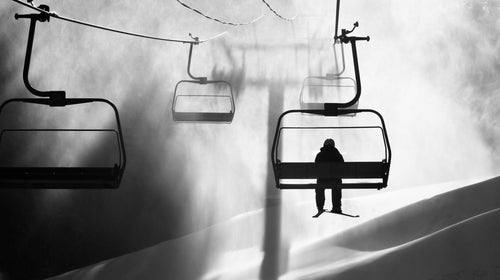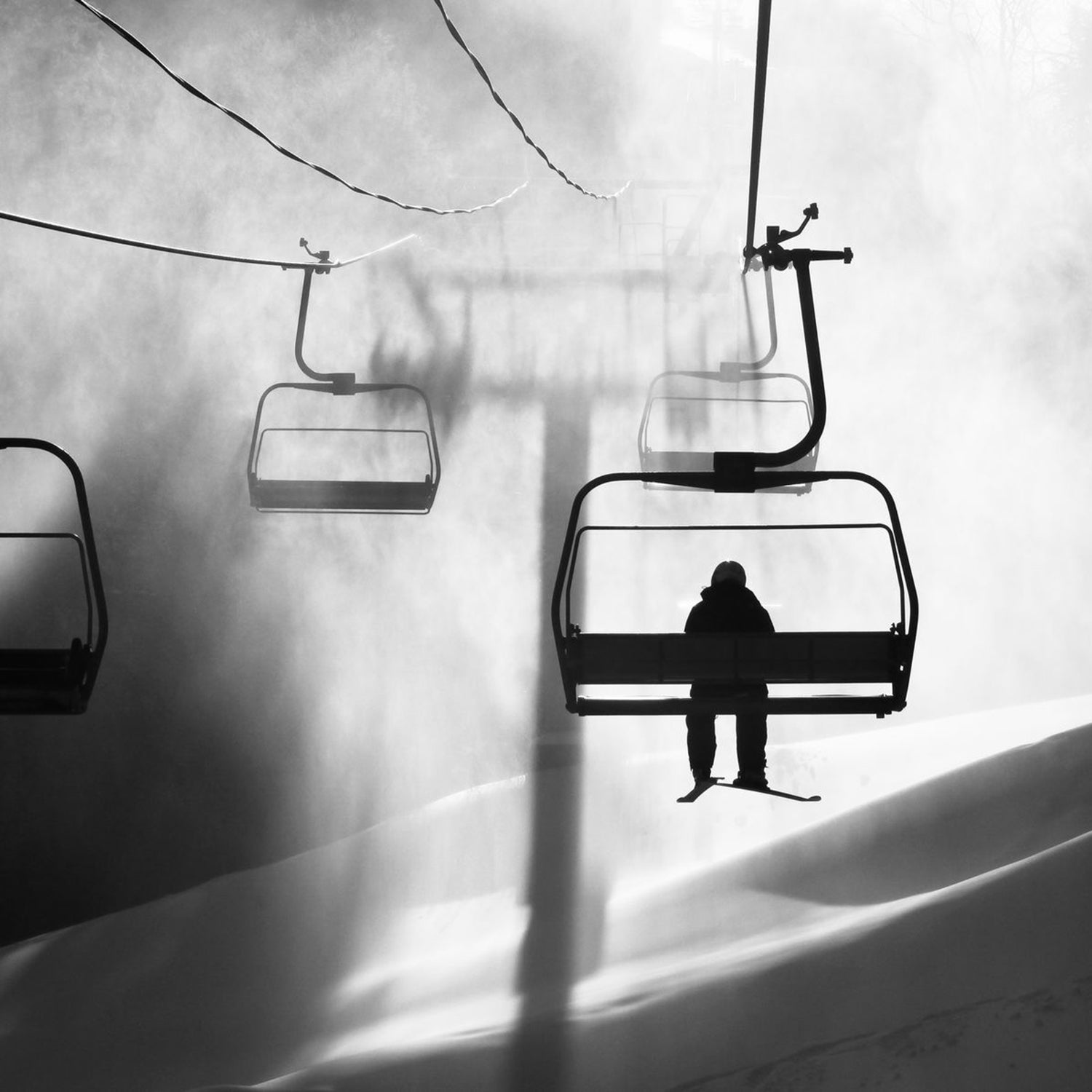The chairlift came to a hard stop about five minutes ago, and now you find yourself—we’ve all done it—asking that question: Can I safely jump from this height?
For most of us, it’s a daydreamy��(or nightmarish) exercise. But depending on where you’re dangling, the answer is… probably not. Exceptions are rare��and usually newsworthy. Earlier this season at a Canadian resort, a crew of and fashioned a crude landing trampoline to catch a kid whose dad was holding him from the chair��by one hand. Barring superteens, though, most chairs are suspended about 30 feet off the deck, so unless it’s a historic powder day, jumping will mess you up.
Well then,��what the hell should you do in the event of a major mechanical lift failure or, worse, if you find yourself stranded on a lift after hours? In the latter case, like the protagonists in the 2010 campy horror flick , you’re facing a scenario that involves a choice between life-threatening self-rescue and a slow death of hypothermia. (The movie spiced things up by adding circling wolves.)
Before throwing yourself to those wolves, there are some things you need to know. Ski areas have contingency plans for when a chairlift breaks down. In the case of a power outage, it’s pretty easy:��Older lifts typically have diesel engines that provide backup juice; they’ll fire those up in a cloud of smoke and get you unloaded in about 10 to 20 minutes. Newer lifts are even slicker, designed so that snowcats can hook into the pulley system and advance the chair slowly for a safe unload.
It’s only a major mechanical meltdown that might keep you on the lift for hours. If, say, the haul rope gets��iced up from snowmaking and derails off a sheave wheel, ski patrol will get��in touch with the lift-maintenance crew and hash out a plan. If the lift can be repaired in the next few hours, and the temperatures aren’t too brutal, get comfy (but not too comfy—skiers have been known to fall asleep and tumble off chairs),��because you’re going to be dangling for a few hours as a��mechanic precariously works the haul rope back over the bogey with a come-along tool. ��Enjoy the complimentary hot chocolate back at the base.
However, if it’s frostbite weather, or if that repair involves a part getting shipped from Germany, ski will patrol spring��into action with a complicated rescue operation called a lift evac. Andrew McCloskey, a��pal of mine and��a fellow ���ϳԹ��� ski tester who has patrolled for 12 years at Alta,��explained how it works at that Utah mountain. Your home hill’s approach might vary.
First, a patroller is sent down the lift line telling��all the victims (sorry, wrong word) to stay calm and not to jump and that help will arrive shortly. Then ski-patrol teams take the lift by sections. One patroller scales the tower uphill from you, clips what is essentially a rope bag with light cord in it to the communications line that runs from tower to tower,��then��scuttles back down the rungs and drags the bag down to your chair. Patrollers fix a wire-stiffened tail of rope to one end of the cord��and haul��it up to you. No longer the passive victim, now you get to feed that rope through an eyelet on the chair and back down to patrol.
You don’t want your loved ones to find you naked with two broken legs.
Next up��the rope comes a fabricated device that looks like a chair without legs. One by one, while remaining seated, you slide your butt onto the chair, slip your arms through some loops, give the thumbs-up, and patrol belays you to the ground. The entire lift should be cleared in two hours.
So now you have a story to tell the grandkids. But for a really compelling tale, you need to get stranded on a lift overnight in temperatures that can kill you. It’s apparently not that hard. (A��quick will pull up half a dozen incidents.)��How does it happen? Enter the lifties—total pros at some resorts,��borderline carnies at others. At the end of the day, the ones at the bottom of the lift are supposed to gate off the loading zone and call up to the upper shack with a designated “last chair.” That’s the primary reason why chairs are numbered—other than busting pot smokers. But��sometimes the lifties aren’t paying attention and get their signals crossed.��Or��this also happens:��you thought you were being clever and slipped past��the gate and onto the lift without them noticing, wanting to��snake one more run. D’oh, you’re going to regret that. Wolves, yo.
Because of where your chair��happened to come to a stop in the woods or over closed terrain, ski patrol missed you on its��end-of-day sweep. It’s now dark and��about eight degrees with the windchill. Nobody can hear your screams. Maybe you read that iconic story in ���ϳԹ��� by Peter Stark about what happens to people that die of hypothermia, and you don’t want your loved ones to find you naked with two broken legs.
Minus the nudity, a young snowboarder in North Carolina found himself in exactly such a��scenario in 2017. After a few hours, as frostbite was kicking in, he chose to jump. But if you know North Carolina skiing, he didn’t land in bottomless powder but rather frozen dirt with a thin coating of man-made snow��on top. The impact broke some bones in his legs and knocked him out. When he came to, he crawled 200 yards out of thick woods, like Leonardo DiCaprio in The Revenant, then crawled another 300 yards to the terrain park, which had just opened for night shredding. Thankfully, he lived. And the kid commands a ton of respect from me. But I can only imagine the response he got from the terrain-park skiers. “Dude, bro, you’re messed up, dude, bro.”
Did he have a better alternative? Is breaking your legs the only play here? To find out, I asked Mickey Wilson, the now famous slackliner and all-around adventurer, who in 2017 dramatically scaled a lift tower and navigated a haul rope to save a buddy who was hanging, strangling on his backpack’s sternum strap. Here’s a condensed take on what Wilson had to say:
“The first thing you do is run your decision matrix. How imperative is it that you get off the chairlift? Do you need to self-rescue, or is it better to wait until morning for help?��If you decide it’s go time, the first thing I’d do is drop the extra weight. My skis. My backpack. Maybe my boots. Don’t toss your gloves, though. Tuck them in a pocket. You might need them, depending on how cold that cable is.
“Once you’re set, carefully stand on the seat, then grab the��top of the bar above you, the frame of the chair. Do a pull-up into a mantle (feet meeting��hands), and swing a leg over that bar so you’re sitting on it like a horse. There’s no rush. Gather yourself, and then pull yourself up��the vertical pole that attaches to the cable with that claw device. Climb it like a stripper pole if you have to. Then grab the cable and mantle on top of it like you’re sitting on a horse again. You need to be a 5.10 climber or the equivalent slackliner to pull this off. You need to be a monkey person.
“Now it’s time to scooch across the cable with your bare hands in front of you and your upper inner thigh dragging along the cable. I wouldn’t try to shimmy under the cable in supermonkey mode unless I only had to go a few feet. That cable is thick. Your arms would seize up. You wouldn’t last. If the tower is close to you, head up the cable to it. But if you’re in the middle of the span, head down. It’s easier. Once you make it to the tower, you’re scot-free. Most modern lifts have catwalks with ladders leading to them for the lift-maintenance people.
“During the rescue I performed, my friend was dying. I went into a flow state. He’d been hanging for two and a half minutes. It was the most intense moment of my life. In a self-rescue, you’d want to visualize everything like a ski racer before you did this, to get in a similar mindset. But you have to know thyself.”
Cool, thanks Wilson. Everyone else, that’s what you do if the lift stops.


